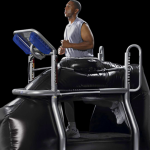 I’ve written previously about the growing use of virtual reality in areas such as rehabilitation. Immersive Rehab is a British startup that is using virtual reality to help people rehabilitate themselves after injury.
I’ve written previously about the growing use of virtual reality in areas such as rehabilitation. Immersive Rehab is a British startup that is using virtual reality to help people rehabilitate themselves after injury.
They wanted to make rehab a more accessible and engaging process, both to start and then to maintain. The process is especially challenging for stroke patients and those with limited mobility, as they struggle to engage with physical objects.
Immersive Rehab aim to help these people by offering both neurological and physical rehab in a virtual environment. Users perform the same kind of movements they would attempt in physical rehab, but they are grabbing and interacting with items virtually. The idea is that they trick the brain into thinking they are engaging with real objects, and thus make important gains in their mobility.
VR isn’t the only novel use of technology being used to support rehabilitation however. A recent paper from researchers at the University of Kent highlights the use of an anti-gravity treadmill to help people recover from knee surgery.
Running to stand still
The researchers are using the treadmill to help reduce fears of re-injury in the patient, and thus increasing their self-belief in their ability to run again on the injured knee.
The paper focuses on the journey of a 39-year-old endurance runner who was undergoing rehabilitation after knee surgery, with the aim of returning to her sport again as quickly as possible. A program was designed using the anti-gravity treadmill to get the lady back on her feet again within eight weeks.
Anti-gravity treadmills are designed to allow users to run or walk without the full weight of their body baring down on their joints. The aim is to help bridge the gap between rehab and a full return to sport. The air pressure in the device can be adjusted to ease the patient back towards 100% of their body weight.
“Not only does the tailored anti-gravity treadmill programme provide a great environment for healing, it also helps the person restore their belief that they can make a successful return to the sport they love,” the authors say.